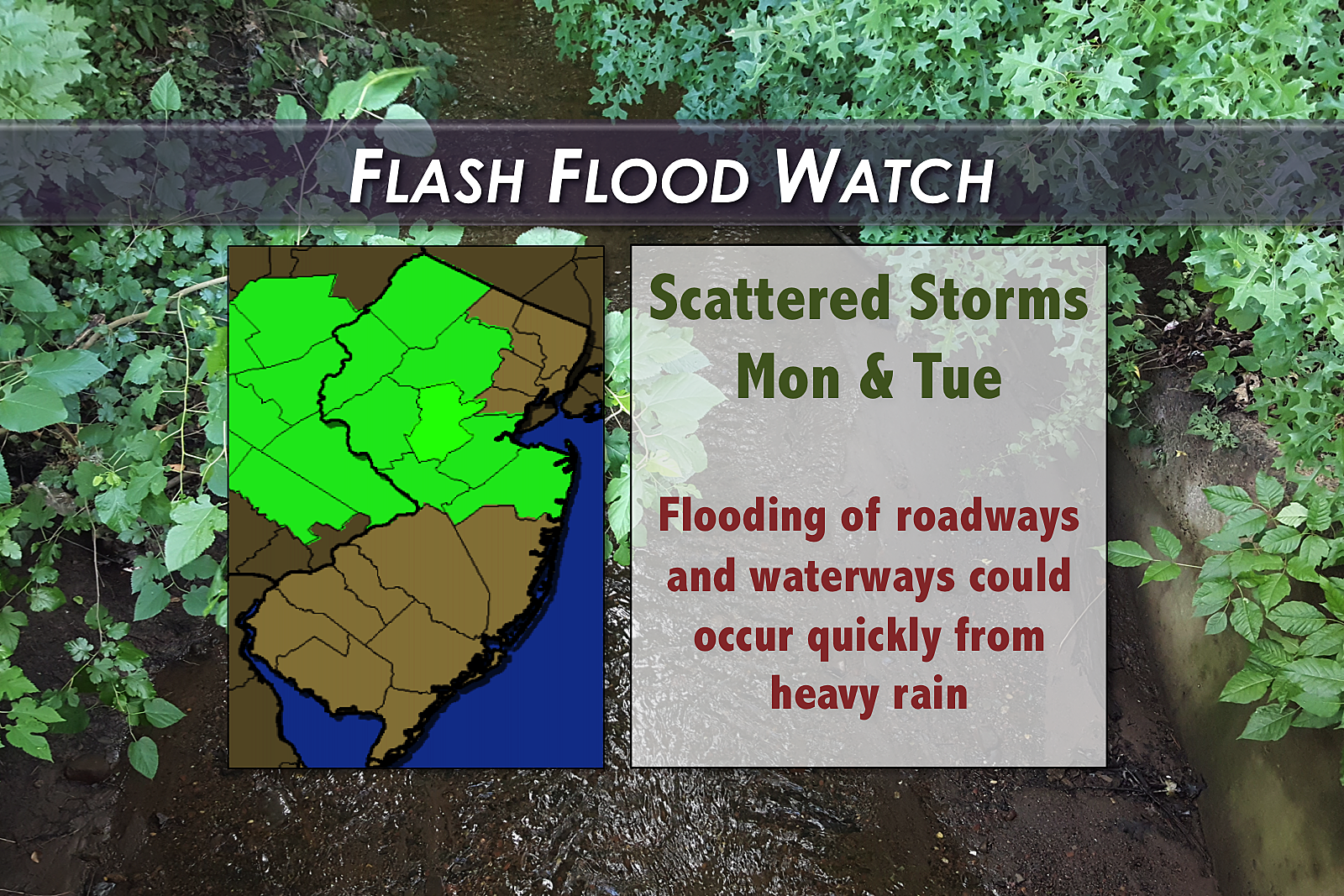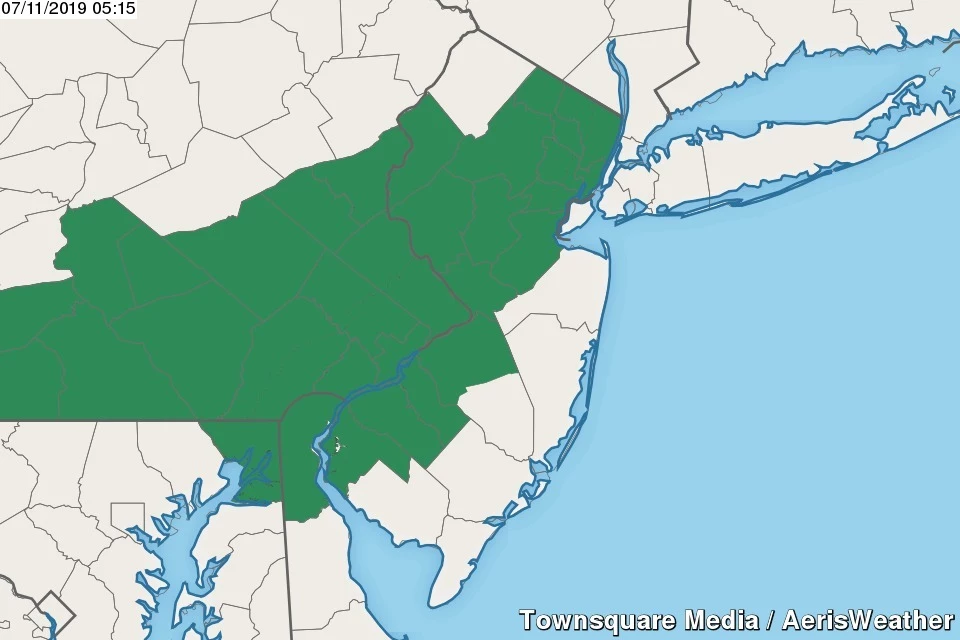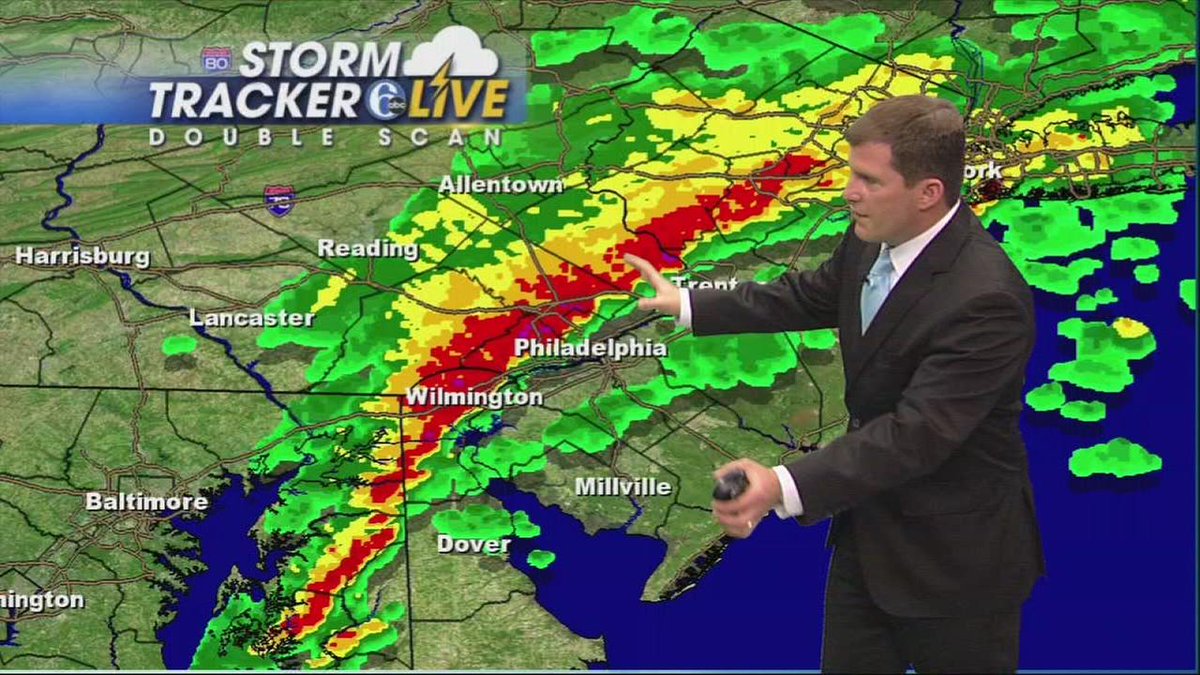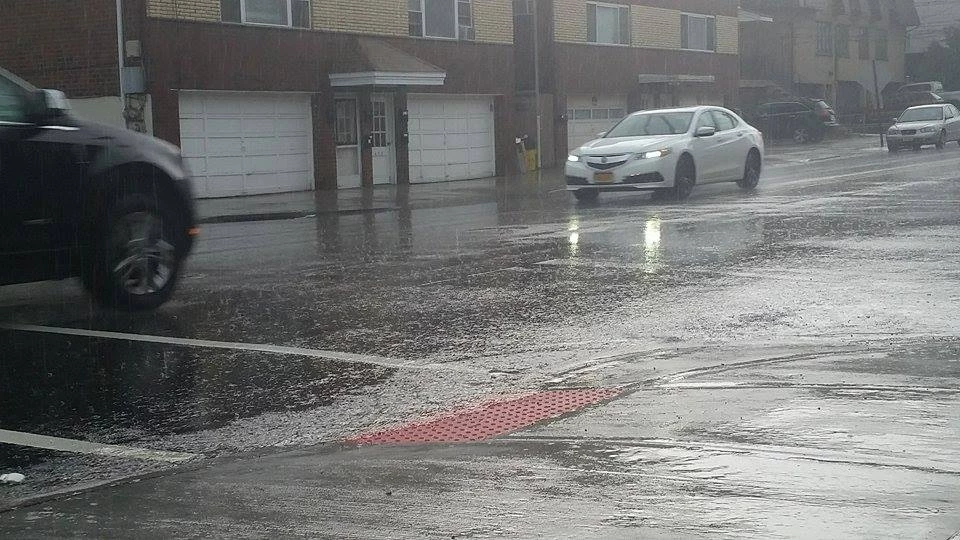Upstream reaches of the Raritan River caused flooding damage in Hunterdon County, where 699 homes were damaged and five were destroyed, and two apartment complexes were severely damaged. The floods damaged 5% of the county's roads, and closed three bridges for a period of two months. In Lambertville, the swollen Swan Creek flooded about 100 homes and damaged a water pipe, leaving the city temporarily without water service. The city's elementary school sustained $1.1 million in damage after it was flooded with nearly 2 ft (0.61 m) of water; it was closed for 12 days.
In Mercer County to the southeast of Hunterdon County, flooding closed about 85 roads, including portions of Interstate 95, U.S. 1 and U.S. 130, and NJ 33. Hundreds of people required rescue after their cars became trapped in the floodwaters. In Trenton, the swollen Assunpink Creek damaged 40 homes and three businesses. The Shabakunk Creek exceeded its banks, damaging nearby homes and business, including a car dealership. High winds damaged the chimney and roof of the Imani Community Church, causing $1.1 million in damage. More than 50 million people in the Northeast alone remained under a flash flood watch or warning, four days after Ida roared ashore in Louisiana as a Category 4 hurricane.
The winds had vastly diminished, but the storm was dishing out heavy rain, much of it in areas already saturated by recent deluges. Hurricane Floyd struck North Carolina on September 16 and moved up the East Coast of the United States, crossing over much of the Jersey Shore as a tropical storm. Ahead of the storm, the National Hurricane Center issued hurricane and tropical storm warnings for the coastline. Following the state's fourth-worst drought in a century, Floyd dropped rainfall across New Jersey, peaking at 14.13 in in Little Falls; this was the highest statewide rain from a tropical cyclone since 1950. The rains collected in rivers and streams, causing record flooding at 18 river gauges, and mostly affecting the Raritan, Passaic, and Delaware basins. A water treatment plant was damaged in Bridgewater Township, forcing nearly 500,000 people in Hunterdon, Mercer, Middlesex, and Somerset counties to boil water for eight days.
The National Weather Service issued a flash flood watch for New York City until Thursday at 2 p.m. City emergency management officials warned that 5 to 6 inches of rain were expected with locally higher amounts of up to 8 inches possible. The storm is expected to bring 1 to 3 inches of rain, a further reduction from earlier forecasts' estimates. Flash flooding in certain areas is possible, as is minor coastal flooding in the tropical storm warning area stretching north from New York's Long Island to Rhode Island. In Morris County, strong winds knocked down hundreds of trees, which damaged dozens of homes.
About 90% of Harding Township lost power when trees fell onto power lines. Floodwaters in Morris County forced about 1,500 people to evacuate, and closed dozens of roads, including U.S. 46 and state routes NJ 10, NJ 23, and NJ 53. In Pequannock, flooding damaged around 250 houses, causing an estimated $5.5 million in damage. One house collapsed in the flooding, trapping two people and a dog inside; they were all rescued.
Floodwaters washed away the Allen Street Bridge in Netcong. The swollen Whippany River forced 50 families to evacuate in Morristown. Floods in Bergen County entered the Lodi municipal building, dozens of homes, an elderly care facility, and Felician University. In Warren County, flooding in an evacuated trailer park in Franklin Township sparked an electrical fire, leading to an explosion of a trailer.
Contaminated floodwaters disrupted public water service in Andover and Hampton Township. Along the Jersey Shore, Floyd caused minor beach erosion and back bay flooding. More significant flooding occurred in the Delaware Valley and its tributaries in the state due to heavy rainfall. A man drowned in the Salem River near Pennsville Township.
In Haddonfield, the Cooper River crested at 3.9 ft (1.2 m) – 1.1 ft (0.34 m) above flood stage. More than 60 people had to evacuate in Burlington, Camden, and Ocean counties, including an elder care facility in Ocean County. The floods closed two bridges and ten roads in the region, including parts of U.S.
Downed trees damaged a house in both Blackwood and Toms River. From April to July, rainfall in New Jersey was 7.14 in below normal, the second-driest for that time period since 1900. In August 1999, then-governor Christine Todd Whitman declared a drought emergency amid the state's fourth-worst drought in a century. Although the state received normal rainfall in the month leading up to Floyd, New Jersey was still in a drought emergency when the storm arrived.
On September 15, 1999, a day before Floyd moved through the state, an approaching cold front dropped over 1 in of rainfall, fueled by moisture from the storm. As Floyd moved through state, it dropped heavy rainfall over a 12 hour period in North Jersey. Across New Jersey, the average rainfall total was 7.05 in , with the highest totals in North Jersey. The peak statewide precipitation during Floyd was 14.13 in in Little Falls, which was the highest rainfall total associated with a tropical cyclone in the state since 1950. More than 12 in of rainfall occurred in Hunterdon, western Somerset, Morris, Essex, Passaic, and Union counties, with the heaviest totals near the Watchung Mountains.
Water capacity in North Jersey reservoirs were 11% below average ahead of the storm, but within a week of Floyd rose to 11% above average. The storm's heavy rainfall caused flooding along rivers and streams, mostly in the northern half of New Jersey. Record flooding occurred at 18 river gauges, including 10 along the Raritan River basin. The worst flooding damage occurred in Somerset County, where several townships became isolated, and about 75% of the bridges were destroyed or damaged. The floods covered several roads, including New Jersey Route 18.
There was also heavy tree damage in the northern half of the county. In downtown Bound Brook, floodwaters reached a depth of 13 ft (4.0 m). The record floods forced nearly 2,000 people to evacuate, including nearly 800 people from the second-story or on the roofs of their houses.
Two people drowned in the city after they refused to evacuate their apartment. An electrical malfunction sparked a fire in downtown that destroyed or severely damaged seven businesses. Firefighters had to use helicopters and boats to put out the blaze. Parts of Manville were flooded to a depth of 10 ft (3.0 m), which damaged 1,500 homes, caused 284 homes to be condemned, and forced 1,000 people to evacuate. The flooding in Franklin Township caused $1.5 million worth of damage to the Zarapeth Community Church, where 20,000 books were destroyed.
When the Green Brook exceeded its banks, the Green Brook Township Municipal Building was covered with nearly 3 ft (0.91 m) of contaminated floodwaters. In Hillsborough Township, flooding from the Millstone and the Neshanic rivers flooded 200 houses and forced 600 people to evacuate. Hurricane Floyd was a long-tracked Cape Verde hurricane that threatened to strike Florida for several days, until a turn toward the north occurred. As Floyd turned away from Florida, the National Hurricane Center issued various tropical cyclone warnings and watches for the East Coast of the United States. On September 15, the NHC first issued a tropical storm watch for the entirety of New Jersey's coastline from the Delaware Bay to the New York Metro area. Early the next day, this was upgraded to a hurricane warning as far north as Manasquan Inlet, with a tropical storm warning extending northward to New York.
These watches and warnings were downgraded and discontinued as Floyd weakened from a hurricane to tropical storm status. Late on September 16, the center of Floyd crossed the Delaware Bay and moved up the New Jersey coastline as a tropical storm, less than 18 hours after the hurricane made landfall in North Carolina. Portions of western Monmouth County also remained under a flash flood warning. The weather service advised residents to seek higher ground and avoid walking through flood waters. On the water, dangerous marine conditions will develop along with strong winds, rough seas, and dangerous rip currents.
Seas will build to six to ten feet in the ocean and the bay conditions will also be rough. Tropical storm warnings have been posted from Manasquan Inlet north to New York City. Hurricane warnings have been issued through much of Long Island and Connecticut. Several beaches in Delaware had been temporarily closed because of the storm. And police in Ocean City asked drivers to avoid southern parts of the tourist town because flooding had already made some roads impassable. Some streets in the New Jersey shore towns of Sea Isle City and Wildwood were flooded, according to social media posts.
Seaside Heights, New Jersey, reported a sustained wind of 37 mph and New York City's John F. Kennedy International Airport reported a wind gust of 45 mph , said forecasters. In North Jersey, two people drowned in their cars in Bergen County. A police lieutenant in Cranford in Union County took his life after coordinating floodwater rescues for nearly 48 hours; the town's police received 750 calls related to the floods.
Gusty winds and saturated soil knocked down hundreds of trees across North Jersey, causing outages to utilities. In Rochelle Park, the Saddle River inundated the Electronic Data Systems building, a data processing center; the outage disrupted service to about 8,000ATMs across the United States. In the same town, flooding in a Bell Atlantic switching facility cut off phone service to one million customers. Downstream the Raritan River, Middlesex County also sustained flooding damage, with more than 30 roads closed. In New Brunswick, about 1,000 people had to evacuate due to the rising Raritan River, which destroyed the city's police department and municipal court.
The flooding damaged 500 homes in Middlesex, with a city damage total of $6 million. In Piscataway, three apartment complexes were flooded, and citywide damage was estimated at $5 million. In Monmouth County, floodwaters closed portions of state routes 35 and 36, as well as six roads in Manalapan Township. The floods washed thousands of industrial drums and barrels into the Raritan Bay and onto adjacent beaches.
It's also going to be breezy through the morning, with some gusts along the coast up to 30 mph. And finally, the Atlantic Ocean will get stirred up a little bit. 1 to 3 foot waves and an elevated risk of rip currents will accompany very localized minor coastal flooding at high tide. "We expect some pretty heavy winds, and we need people to be ready for that, and some flash flooding in certain parts of the city," New York City Mayor Bill de Blasio said at a briefing Friday morning. In Central Jersey, Floyd's heavy rainfall was a 1-in-100 year event.
The rains accumulated in rivers and streams, causing record or near-record flooding at four locations along the Raritan River. In Bound Brook, the Raritan crested at a record 42.5 ft (13.0 m) on September 16, well above the 28 ft (8.5 m) flood stage, and exceeding the previous record of 37.5 ft (11.4 m) set during Tropical Storm Doria in 1971. In Manville, the Raritan crested at a record 27.5 ft (8.4 m), nearly double the flood stage of 14 ft (4.3 m). The Millstone River crested at a record 21 ft (6.4 m), more than double the flood stage of 9 ft (2.7 m). Despite being built to withstand a 500 year flood, excessive floodwaters damaged a water treatment plant in Bridgewater Township. Consequentially, nearly 500,000 people in Hunterdon, Mercer, Middlesex, and Somerset counties had to boil water for eight days.
Several schools could not reopen until the water flow was restored. Other sewage treatment plants in the region were unable to withstand the rush of water, causing raw sewage to be released into rivers and streams. In North Jersey, flash flooding began in some areas overnight. Bands of heavy rain overwhelmed storm drains and drivers plowed through foot-deep water in Newark and Hoboken, and in New York City.
Social media is not designed to replace existing infrastructure that disseminates "Short-fused" or time critical warnings from the national weather service such as NOAA Weather Radio and the emergency alert system. "Stay off the roads, stay home, and stay safe," New Jersey Gov. Phil Murphy said on Twitter amid dozens of videos going viral on social media, showing streets with rapid-moving water. Murphy declared a state of emergency in all of New Jersey's 21 counties, urging people to stay off the flooded roads. Point Pleasant Beach current severe weather warnings, watches and advisories as reported by the NOAA National Weather Service for the Point Pleasant Beach area and overall Ocean county, New Jersey. As of 7 a.m., the storm was moving north at 18 mph, with sustained winds as high as 70 mph, an advisory warned. Traffic-disrupting flooding on roads causing a road closure in Middlesex County, New Jersey.
After downtown Bound Brook was under 12 ft (3.7 m) of floodwaters, the New Jersey Department of Environmental Protection worked with the New York District of the Corps of Engineers to build the Green Brook Flood Control Project. The $110 million project was designed to withstand a 150 year flood. The flooding in Bound Brook affected Hispanic immigrants living in crowded homes; after the storm, there were reports of rent gouging and harassment toward Hispanic residents, including late-night housing inspections.
In 2003, New Jersey Governor Jim McGreevey signed into law a bill to prevent landlords from raising rents more than twice the inflation rate within 10 mi of a disaster area. Due to complaints, the United States Department of Justice sued Bound Brook in 2004, which resulted in a change in the borough's housing policy. FEMA opened three disaster recovery centers and three mobile units to provide information about federal assistance, which ultimately assisted 4,241 people. Applications for federal assistance ended two months after the storm struck on December 17, 1999.
The state received more than $7.5 million to repair public facilities. FEMA worked with New Jersey to buy and tear down 44 flooded homes in Manville. Following the storm, the name "Floyd" was retired and removed from the Atlantic hurricane naming list. This declaration allowed for emergency funding to be used for debris removal, restoring public facilities, unemployment benefits for storm victims, and public assistance for homes and businesses.
FEMA – the Federal Emergency Management Agency – as well as other federal agencies provided over $277 million in assistance to New Jersey. In addition to the storm's rainfall, Floyd produced gusty winds. The strongest observed winds in the state occurred at Newark Liberty International Airport, which recorded sustained winds of 44 mph (70 km/h), and gusts of 53 mph (85 km/h).
Floyd produced above normal tides along the eastern United States coastline. In Cape May, tides reached 7.36 ft (2.24 m) above mean sea level, which equates to a storm surge of 2.6 ft (0.79 m). No storm surge impact is predicted, though there may be minor back bay flooding. Rip currents will last through "at least Sunday," the statement said. Jersey Shore residents were closely monitoring Tropical Storm Henri Saturday morning, amidst the issuance of hurricane and tropical storm warnings in the region.
By Saturday night, it was pouring and several flash flood warnings were issued across New Jersey. Video posted to Twitter shows flooding on southbound Route 21, right before Interstate 280. Flash flood warnings were issued beginning Saturday night and into Sunday morning throughout the five boroughs. The National Weather Service said drivers had to be rescued after they got stuck in a flash flood on 3rd Avenue beneath the Gowanus Expressway and between 4th Avenue and Carroll Street late Saturday. And the second, a storm system will slide from west to east across New Jersey Sunday morning, dragging through some rain showers. These raindrops look pretty limited in terms of intensity and duration.
And before they arrive, our ground and waterways will have a chance to dry out substantially. So it's just going to be some wet weather - not a resurgence of flooding issues. With regards to storm surge of 2 to 4 feet it will occur east of the track of the storm so mainly from the coast of Central Long Island eastward to Block Island. The wind in the opposite direction on the west side will blow the water out. Remember if the track is further west you will have to adjust the western boundary of the surge. I could have pulled any model and no two had the same track so I opted for the HRRR model from 1pm today through 1am Monday.



























No comments:
Post a Comment
Note: Only a member of this blog may post a comment.